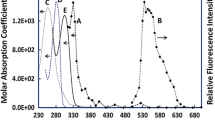Abstract
Diffusion-controlled fluorescence quenching for perylene by dinitrobenzene has been examined; Smoluchowski's equation does not apply. The reaction radius R in relatively viscous solvents (isopropanol and benzonitrile) exceed the contact radius by more than a factor two. R decreases as the mutual diffusion coefficient D increases. The in D dependence for R has been used to determine the electron-tunneling parameters. The Frank-Condon factors increase with the electron-acceptor strength. Electron-tunneling barrier heights from excited perylene to the oxidizing agent have been calculated. It is concluded that virtual solvent states are involved.
Similar content being viewed by others
Literature cited
E. I. Kapinus, I. Yu. Kucherova, and I. I. Dilung, “Effects of solvents on fluorescence quenching for aromatic compounds by electron acceptors,” Teor. Éksp. Khim., 18, No. 5, 572–578 (1982).
E. I. Kapinus, I. Yu. Kucherova, V. P. Staryi, and I. I. Dilung, “The role of long-range electron transfer in fluoresence quenching,” Dokl. Akad. Nauk SSSR, 279, No. 4, 920–924 (1984).
E. I. Kapinus, I. I. Dilung, I. Yu. Kucherova, and V. P. Staryi, “Stereospecificity in excited aromatic-compound quenching by electron acceptors,” Teor. Éksp. Khim., 22, No. 5, 585–590 (1986).
E. I. Kapinus, I. Yu. Kucherova, and I. I. Dilung, “The effects of the solvent on anthracene fluorescence quenching by aromatic ions,” ibid., 21, No. 3, 370–374 (1985).
A. Weissberger, E. Proskauer, J. Riddick, and E. Toops, Jr., Organic Solvents [Russian translation], Izd. Inostr. Lit., Moscow (1958).
R. Reed and T. Sherwood, Properties of Gases and Liquids [Russian translation], Khimiya, Moscow (1971).
E. D. Katz and R. P. W. Scott, “Use of Chromatographic data to determine the molecular weight of a solute from a liquid Chromatographic column,” J. Chromatogr., 270, No. 1, 29–50 (1983).
A. I. Burshtein, “Molecular-kinetic aspects of condensed-state chemical physics,” Usp. Khim., 47, No. 2, 212–233 (1978).
Yu. A. Berlin, “Allowance for diffusion and tunneling transitions in describing acceptor-molecule electron-capture mechanisms,” Dokl. Akad. Nauk SSSR, 223, No. 3, 625–628 (1975).
N. Sutin, “Nuclear, electronic, and frequency factors in electron-transfer reactions,” Acc. Chem. Res., 15, No. 9, 275–282 (1982).
R. A. Marcus and N. Sutin, “Electron transfer in chemistry and biology,” Biochem. Biophys. Acta, 811, 269–322 (1985).
K. I. Zamaraev, R. F. Khairutdinov, and V. P. Zhdanov, Electron Tunneling in Chemistry [in Russian], Nauka, Novosibirsk (1985).
É. G. Petrov, Biosystem Charge-Transfer Physics [in Russian], Nauk. Dumka, Kiev (1984).
Kh. S. Bagdasar'yan, Two-Quantum Photochemistry [in Russian], Nauka, Moscow (1976).
S. G. Éntelis and R. P. Tuger, Liquid-State Reaction Kinetics [in Russian], Khimiya, Moscow (1973).
A. V. Gurvich, G. V. Karachevtsev, V. N. Kondrat'ev, et al., Bond Energies, Ionization Potentials, and Electron Affinities [in Russian], Nauka, Moscow (1974).
B. S. Yakovlev, “Excess electrons in nonpolar molecular liquids,” Usp. Khim., 48, No. 7, 1153–1179 (1979).
M. A. Krivoglaz, “Electron fluctuation states,” Usp. Fiz. Nauk., 111, No. 4, 617–654 (1973).
Y. Nakato, “Photoelectron ejection from tetraamino-ethylenes in aromatic hydrocarbons. Role of the molecular Rydberg state in excited charge-transfer states and long-range electron-transfer processes,” J. Am. Chem. Soc., 98, No. 23, 7203–7208 (1976).
Author information
Authors and Affiliations
Additional information
Translated from Teoreticheskaya i Éksperimental'naya Khimiya, Vol. 24, No. 6, pp. 672–677, November–December, 1988.
We are indebted to G. P. Gurinovich, Corresponding Member, Belorussian Academy of Sciences, for support in this work and for providing facilities for the measurements, and to Professor A. I. Burshtein for discussion.
Rights and permissions
About this article
Cite this article
Kapinus, E.I., Dilung, I.I. Long-range perylene fluorescence quenching by electron acceptors. Theor Exp Chem 24, 643–648 (1988). https://doi.org/10.1007/BF00531356
Received:
Issue Date:
DOI: https://doi.org/10.1007/BF00531356




